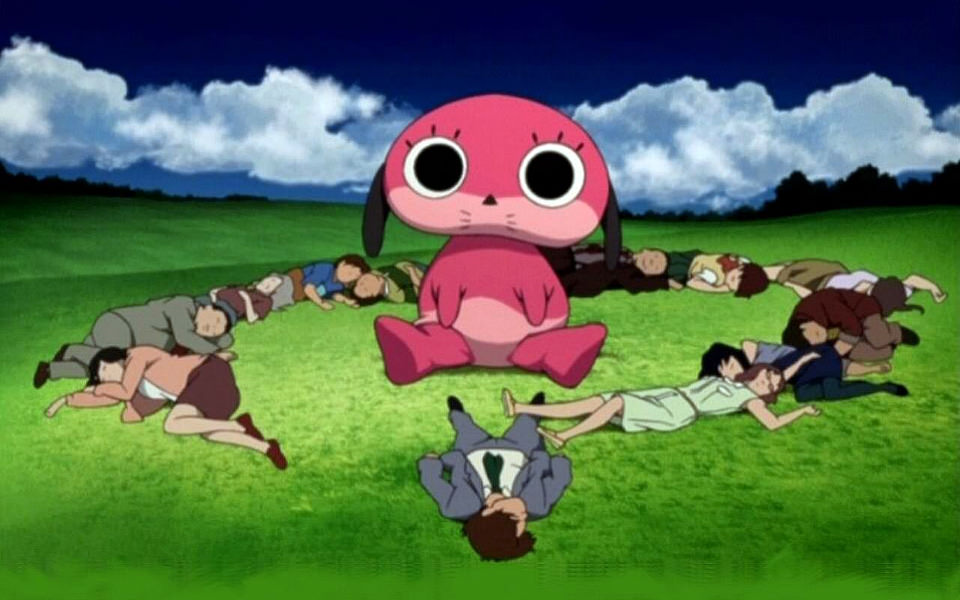Paranoia Agent, Volume 1 by Satoshi Kon (Review)

The opening credits of Paranoia Agent is easily one of the most compelling — and disturbing — opening sequences I’ve seen in a long time. A series of individuals are seen standing in the midst of various disasters, ruins, and desolate wastelands, and they’re all laughing hysterically. Meanwhile, the series’ triumphant opening theme plays in the background. Triumphant, that is, until you realize that the vocalist is singing, quite enthusiastically, about mushroom clouds and tsunamis.
One of the last images we’re left with is that of an old man in a tuxedo standing on the surface of the moon, laughing hysterically as the Earth’s surface is dotted with what looks like shockwaves from massive explosions. It’s essentially a vision of a world gone insane, a world that leaves its inhabitants hysterical and delusional concerning the destruction and violence surrounding them. Which seems to be the point driving Paranoia Agent, the latest anime from the mind of Satoshi Kon (Millennium Actress, Tokyo Godfathers).
On paper, the series’ premise sounds a little dubious. Several seemingly random attacks have been taking place in an area of Tokyo, all of them committed by a young boy in golden rollerblades who wields a golden baseball bat. The first victim is Tsukiko, a designer for a toy firm who has been under an increasing amount of stress at work. The second is the sleazy tabloid reporter who has been following her around, trying to get the scoop on her story. The next two are schoolboys, followed by a meek young woman who suffers from a split personality and moonlights as a hooker, and finally, a beat cop who is on the take.
Meanwhile, two detectives, one a fresh-faced rookie and the other a grizzled veteran, serve as the audience’s ears and eyes, attempting to make sense of apparently senseless acts of violence — and even wondering if that’s even possible anymore in this day and age.
Although the individuals all seem unconnected at first, the series does a brilliant job of slowly revealing the common threads that bind all of them together. Using flashback, nonlinear storylines, random encounters, and subtle clues, we see just how these people are related. For example, the young woman moonlighting as a hooker is, in fact, the tutor of one of the schoolboys, and the corrupt cop is one of her clients.
However, there’s something even deeper that binds these characters together. In their own way, they’ve all been driven insane by the society around them, forced into living lives they don’t want to lead, doing things they don’t want to do. Modern society has made them cautious, meek, arrogant, slothful, corrupt, and manipulative. They’ve become alienated, cut off from eachother. They interact only through cellphones, text messaging, and online discussion forums. And worst of all, they’ve become numb, ignorant of the troubling reality around them. It’s not until a violent encounter with the so-called “Shonen Bat” that they start to wake up and see what’s really going on.
Obviously, given that this is just the first volume, there are still a lot of unknowns going on here. Although some of the characters’ storylines seem played out, there are still plenty of unanswered questions, with plenty more on the way. However, Kon (who is easily one of the most interesting and thought-provoking voices currently working in anime today) has already packed a lot into these first 4 episodes, ending things on a very compelling note that makes Volume 2 an absolute must-see.
As with all of Kon’s productions, Paranoia Agent is visually stunning. The character designs are far more realistic than most anime, often eschewing the cliched “big eyes” look. And the animation, courtesy of Madhouse (Ninja Scroll, Texhnolyze, Vampire Hunter D: Bloodlust) is topnotch throughout. And then there’s the music of Susumu Hirasawa (who also contributed to Millennium Actress’ wonderful score), which perfectly accentuates the anxiety and tension permeating each episode.
While watching Paranoia Agent, I couldn’t help but compare it to Gantz, another dark, stylish anime that’s been generating a bit of buzz. Both are similar thematically, as they both deal with the darker sides of human nature with an almost apocalyptic tone. However, Paranoia Agent is so far the superior series, and in nearly every way.
From a technical standpoint, Madhouse’s animation and character designs reveal Gantz as the spotty work that it is. All technical aspects aside, however, Paranoia Agent is a far more compelling work, always maintaining the dark and disturbing tone while never devolving into a mess of unlikable characters, boring exposition, and gratuitous sex and violence. Even the plotline involving the prostitute alter-ego is handled in a manner reminiscent of Kon’s Perfect Blue, bringing us into the mind of a woman who is slowly losing hers, allowing us to experience her growing dementia as she realizes the wages of her sins.
At just 13 episodes, I find myself wondering just how in the world Kon will wrap these things up. Or if he will even attempt to do so. Somehow, wrapping up the series in a nice, neat bow seems like a bit of a cop-out for this series, which exposes so thoroughly the seeming mindlessness of modern society. Paranoia Agent more than lives up its name, presenting a very dark and dim outlook on things. However, for those of you looking for anime with substance and depth, plus tons of style and atmosphere, I can’t recommend Satoshi Kon’s latest work highly enough.
